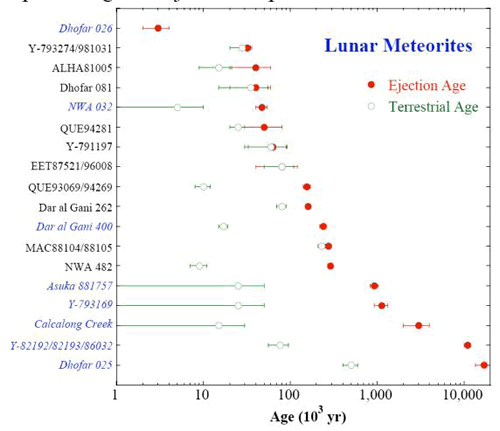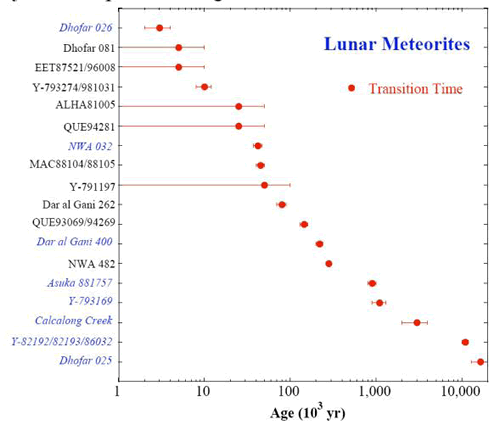How do lunar meteorites get to Earth? Theory and measurements
The idea that meteorites could be ejected from the Moon and arrive at Earth is not particularly new (e.g., Arnold, 1965; Wetherill, 1968), but evidence was lacking until the discovery of ALH A81005. After initial assessments of Melosh (1984) and cosmic ray exposure age dating (see review of Eugster, 1989), Warren (1994) showed that many of the lunar meteorites could have been ejected from small craters, and that at least six individual craters were involved. Although the number of craters has certainly changed given the multitude of new lunar meteorites reported since then (now 62).
Using two different models for ejection dynamics (Earth-Moon-Sun-outer planets) Gladman et al. (1995) showed that fragments of the Moon that were ejected between speeds of 2.4 and 3.6 km/s from the surface of the Moon (just above the escape velocity) would stay in terrestrial orbits only up to approximately 10 Ma.
Comparison of the modeling results agrees nicely with the distribution of 4 exposure ages (transition times, which corresponds to exposure as a small object in space) determined on the lunar meteorites (see Figure 1). However, with all of the new lunar meteorites, and additional revisions to impact dynamics (e.g., Head et al., 2002) it is probably worth revisiting this problem in more detail. Nonetheless, it appears that the ages correspond to 4 exposure ages, rather than 2 exposure ages that would result from exposure at the surface of the Moon.
Another aspect of lunar meteorites related to their ejection and launching from the surface of the Moon, is their lower porosity compared to Apollo samples collected at the surface.
Warren (2001) showed that eight lunar meteorite breccias have lower porosities (~3%) than 44 analogous Apollo samples (~ 25%). He attributed this difference to two factors: a) stronger and more compact breccias are more likely to have survived the launch to lunar escape velocities, and b) lunar materials are likely to have become compacted and less porous during the impact and shock event that ejected them from the Moon (Warren, 2001). Again, densities should be evaluated in light of the many new meteorites that have been found, including 10 of basaltic composition.
Finally, it has been recognized that some meteorites may be different rock types that were ejected or launched together from the same impact event. These are said to be launch paired.
Some meteorites are suggested to be launched paired based on their For example, Yamato 793169, Asuka 881757, MIL 05035, and MET 01210 are likely launch paired based on their similarity of composition, exposure histories, and crystallization ages (Korotev et al., 2003; Korotev, 2006; Arai et al., 2005; Zeigler et al., 2007).
It has been proposed that NWA 032 is related to the LAP basalts (Korotev, 2006). And the mingled meteorites, Yamato 793274/981031, QUE 94281, and EET 87521/96008 have all been suggested to be launch paired based on their similar composition, texture, lithology, and exposure history (Korotev et al., 2003; Korotev, 2006, and references therein). However, no other meteorites have been definitively launch paired, although evidence to the contrary may be presented in the future.
As a result it seems clear that the lunar meteorites represent a large number of source craters, and thus represent samples from a large and random portion of the lunar surface.

Figure 1a: Ejection ages and terrestrial ages of lunar meteorites, taken from the most recent work of Nishiizumi et al. (2004)

Figure 1b: Transition times of lunar meteorites, taken from the most recent work of Nishiizumi et al. (2004)
